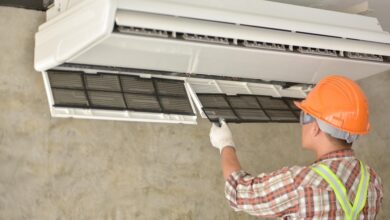7 Reliable Fixes for Hot Airflow Problems
When the sweltering heat rolls in and your AC seems to be working against you by blowing hot air, it can feel utterly frustrating. However, the good news is that many hot airflow issues can be diagnosed and resolved without over-complicating the situation. This guide will cover 7 proven fixes for hot airflow problems, offering practical advice that you can try to restore your cooling system’s efficiency.
1. Check Your Thermostat Settings
It might sound basic, but incorrect thermostat settings are often the culprit behind your HVAC system blowing hot air. Make sure it’s set to “Cool” mode instead of “Heat” and double-check the temperature settings.
Additionally, inspect whether the fan is set to “On” or “Auto.” When set to “On,” the fan will run continuously, even when the AC isn’t cooling, which could make it feel like hot air is being pushed out. Switch to “Auto” mode to ensure your AC is cycling properly.
2. Replace Your Dirty Air Filter
Clogged or dirty air filters obstruct airflow, causing uneven cooling or hot air. When the system struggles to push air through the filter, it loses efficiency and might circulate warm air around your home.
Experts recommend replacing or cleaning air filters every 60–90 days or more frequently if you have pets or live in a dusty environment. Keeping this simple routine in check could easily solve your hot airflow issues.
3. Inspect and Clean Coils
Your AC’s condenser and evaporator coils play a critical role in cooling the air. Dirty coils, covered in debris or dust, reduce heat transfer efficiency, leading to warm air coming from the system.
Regular maintenance is necessary to prevent buildup. Shut off the power and use a soft brush or foaming coil cleaner to clean away grime. This straightforward solution can help your cooling system function optimally.
4. Ensure Proper Refrigerant Levels
Low refrigerant is a common reason why your AC isn’t cooling as it should. If you notice symptoms like warm air or frozen coils, it’s likely an issue with refrigerant levels.
Refrigerant doesn’t naturally reduce over time, so a low level likely signals a leak. Hire a professional to locate and fix leaks while recharging the refrigerant to the correct levels. This delicate task requires expertise, so avoid DIY fixes.
5. Check for Blocked Air Ducts
The ductwork in your home needs to be free of obstructions for consistent cooling. Dirt, debris, or even small pests can obstruct air ducts, preventing the system from delivering cool air.
Inspect the vents in every room for visible blockages. If necessary, schedule professional cleaning for more thorough ductwork maintenance. Ensuring clear airflow channels is critical to solving hot airflow problems.
6. Clean Around the Outdoor Unit
Your AC’s outdoor unit needs sufficient airflow to function efficiently. If the area around it is cluttered with debris, leaves, or vegetation, it could cause the system to overheat and blow warm air.
Clear at least 2–3 feet of space around the unit and regularly check for dust or obstructions on the condenser fins. Keeping the outdoor area clean and unobstructed ensures proper heat dissipation, allowing your AC to work effectively.
7. Schedule Professional Maintenance
If none of the above fixes solve the problem, it’s time to call an expert. A trained technician can identify more complex issues, such as electrical malfunctions or failing components. If you’re in need of AC servicing, consider AC repair in Salt Lake City. Technicians can quickly troubleshoot and get your cooling system back on track.
By addressing these 7 areas, you can tackle the most common causes of hot airflow problems and restore your home’s comfort.
